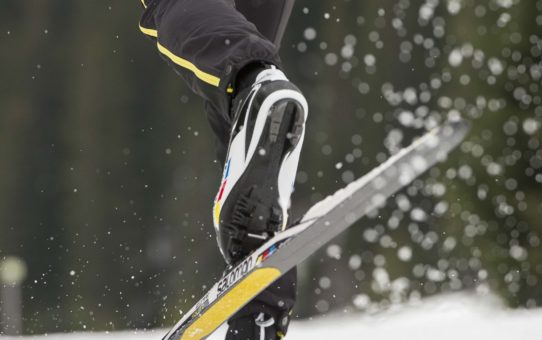Nordic skin skis: the new "in" skis?

The term "skins" means something different here at the store than a team of shirtless men running around a basketball court.
Originally made of actual animal skin, these strips of natural or synthetic "fur" allow a ski to glide in one direction while anchoring grip in the other.
Skin technology has been around a long time and is usually associated with backcountry skiing. In the past few years major ski companies have been developing versions of nordic skin skis meant for groomed trail skiing. These now range from recreational touring skis to parallel sidecut racing skis with top-quality base construction. If you look at the bottom of a skin ski, you will see the skin strip attached under the kick zone.

Two thirds of us at Eb's own skin skis (and have for several years). Our fear these days is that we are getting so spoiled with them we may end up selling our full wax boxes. Yet while we are fully enjoying the skin experience, you may not yet be sold. Here are some questions we commonly get asked about skins.
How fast are they?
Skin skis are significantly faster than traditional cut-base waxless skis. Your fastest ski will still be a waxable ski, but nordic athletes are competing with skin skis on the World Cup circuit when conditions are difficult for waxing.
Are they noisy?
Not at all. Only occasionally have a couple of us noticed a faint buzzing sound as we've gone down a hill.
Can you feel the skin as you ski?
When sized correctly and used with good technique (so the skin is off the snow during the glide phase) the ski feels and glides just like a waxable ski. During the kick you may notice more of a grippy feel than you do with wax. Kevin says he can climb better in his skins than he can with his waxable skis.
If you are on uneven snow or ski over debris you may feel the skin "grab" a little. As you ski more on your skins you will learn when this may happen and be more prepared for it. Try to avoid debris.
How long does the skin last?
If used on clean snow the skin will last anywhere from 3-5 years or more. Kevin has over 400 km on his skins and they are still almost like new. (Note: Kevin is not easy on his skis.)
What do I do when the skin wears out?
Replacement skins cost anywhere from about $30 to $90. You can change the skins yourself but we also offer that service at the store.
Do skin skis need any special treatment?
No, but we highly recommend applying an anti-icing agent (such as Swix Skin Care) which increases your glide and helps prevent icing. This also helps with grip (see below).
Treat your skin skis as you would other skis. Store and transport them with the bases together for protection.
What if the skins get dirty?
Do your best to avoid debris as this will prematurely wear your skins. Over time the skins will pick up wax residue and particles from the snow, but this is easy to clean off with a skin cleaner (such as Swix Skin Cleaner). Simply spray the skin and wipe off with Fiberlene.

Do you ever need to wax skin skis?
Never apply grip wax to your skin skis! All you need to do is get the glide zones hot waxed every 100km or so as you would any other ski. You can also apply liquid glide wax (such as Vauhti LF or HF Liquid Glide) to the glide sections of your skis which will significantly increase your efficiency and glide.
I don't have enough grip. What's going on?
There are a few things that could be happening here. Commonly this problem is solved as soon as you start applying anti-icing (Skin Care) products to your skins. This stuff is like Teflon - it reduces the friction between the ski and the snow, thereby improving glide and helping prevent icing especially when the snow is around zero degrees.
The other thing to do is bring your skis in somewhere warm after you ski. The skin hairs get wet even in the cold (due to friction) and can freeze together, greatly reducing the amount of grip you get. Give your skins a chance to dry out properly before you ski next.
Lastly, good technique always helps with grip. Strive for full weight transfer so you can compress your skin properly into the snow when you kick.
Are skin skis appropriate for Saskatchewan conditions?
Absolutely. Because we often get freeze-thaw conditions during the winter we consider skins one of the best skis you can get for this province. It is very difficult to find a wax that works when it is around the freezing mark, and you never have to mess with grip waxes and klister if you have skin skis. They also work well in cold or warm conditions so are very versatile.


Comments
Leave a comment